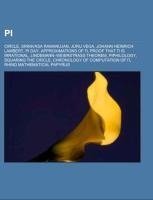
Pi
Source: Wikipedia. Pages: 53. Chapters: Circle, Srinivasa Ramanujan, Jurij Vega, Johann Heinrich Lambert, Pi Day, Approximations of p, Proof that p is irrational, Lindemann-Weierstrass theorem, Piphilology, Squaring the circle, Chronology of computation... Viac o knihe
Produkt je dočasne nedostupný
16.28 €
bežná cena: 18.50 €
O knihe
Source: Wikipedia. Pages: 53. Chapters: Circle, Srinivasa Ramanujan, Jurij Vega, Johann Heinrich Lambert, Pi Day, Approximations of p, Proof that p is irrational, Lindemann-Weierstrass theorem, Piphilology, Squaring the circle, Chronology of computation of p, Rhind Mathematical Papyrus, Proof that 22/7 exceeds p, List of formulae involving p, Indiana Pi Bill, Rhind Mathematical Papyrus 2/n table, Feynman point, William Shanks, Peter Borwein, Chudnovsky brothers, Akira Haraguchi, Cadaeic Cadenza, Ludolph van Ceulen, Milü, Adriaan van Roomen, A History of p, Pilish, William Rutherford, Yasumasa Kanada, Lu Chao, List of topics related to p, Hiroyuki Goto. Excerpt: (sometimes written pi) is a mathematical constant whose value is the ratio of any circle's circumference to its diameter; this is the same value as the ratio of a circle's area to the square of its radius. is approximately equal to 3.14159 in the usual decimal positional notation. Many formulae from mathematics, science, and engineering involve , which makes it one of the most important mathematical constants. is an irrational number, which means that its value cannot be expressed exactly as a fraction, the numerator and denominator of which are integers. Consequently, its decimal representation never ends or repeats. is also a transcendental number, which implies, among other things, that no finite sequence of algebraic operations on integers (powers, roots, sums, etc.) can be equal to its value; proving this was a late achievement in mathematical history and a significant result of 19th century German mathematics. Throughout the history of mathematics, there has been much effort to determine more accurately and to understand its nature; fascination with the number has even carried over into non-mathematical culture. Probably because of the simplicity of its definition, the concept of has become entrenched in popular culture to a degree far greater than almost any other mathematical construct. It is, perhaps, the most common ground between mathematicians and non-mathematicians. Reports on the latest, most-precise calculation of are common news items. The current record for the decimal expansion of , if verified, stands at 5 trillion digits. The Greek letter was first adopted for the number as an abbreviation of the Greek word for perimeter (pe¿¿µet¿¿¿), or as an abbreviation for "periphery/diameter", by William Jones in 1706. The constant is also known as Archimedes' Constant, after Archimedes of Syracuse who provided an approximation of the number, although this name for the constant is uncommon in modern English-speaking contexts. Lower-case denotes the constant
- Vydavateľstvo: Books LLC, Reference Series
- Formát: Paperback
- Jazyk:
- ISBN: 9781157561248


 Anglický jazyk
Anglický jazyk 







 Nemecký jazyk
Nemecký jazyk 